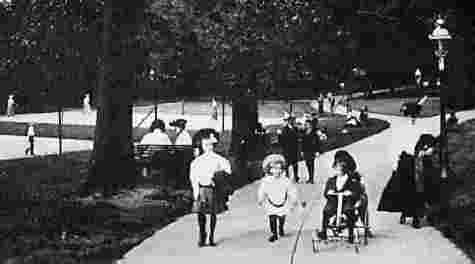
Figure 1.--This photograph shows children in Louisville's Central Park during 1907. Note how dressed up the children are with wide-brimmed hats, tunics, and sailor suits. |

|
After the turn of the century photography moved out of the studio. The new snpshot at the turn of the 20th century provides countless wonderful outdoor images, including the many urban parks that began appearing in the Victorian era. Thus we have a much fuller understanding of the parks, the facilities at the parks, how they were used, and the popular fashions. Thus for the first time we have much fuller understanding of the urban parks. We continue to see rather formal uses of the parks. People including the children still dressed up forbpark outings. But we see more children in the parks enjoying outings. The omages show rther sedate usage, the children walking with their parents or nannies. The children were still dressed up in Fauntleroy suits at the turn of the century. And sailor suits contnued to be popular even after the turn-of-the century. Tunic suits seem particularly popular througout the Edwardian era. There do not seem a lot of facilities specifically designed for the children, but they still made good use of the parks.
Park outings during the Edwardian era continued to be important events in the daily life of nursery-bound children. The pattern set in the Victorian period continued into the Edwardian era until the disruptions of the First World War (1914-18) brought about social and economic changes that changed child-rearing practices, especially the practice of confining small children to a nursery run by a nanny. Daily or periodic park outings for Edardian children, however, to the major public and local public and private parks continued to be the highlight of many children's day. Some of the better known parks are discussed on the Victorian park outing page. Visits to these parks were often the most exciting event of the day for the children. I believe continued to be the nanny's duty to take the children. I believe it was rather rare for the affluent Edwardian mothers, as it had been or Victorian mothers, to supervise the children on these outings. I also think it was not the job of the governess who was primarily responsible for instruction, although she may have been involved with the outings of the older children. There may have well been some differences between countries. French and Italian mothers, for example, may have been more involved in raising the children as they do not seem to have insisted on confining the children so strictly to the nursery as the English. This is dicussed in more detail in the Victorian outing page
Even though park visits were esentially play outings, the Edwardian
child, like his Victorian father, was often outfitted in rather formal
clothes for these outings. Fortunately, the photographic record
offers a much richer insight into clothing styles for park outings for most of the 19th century. Drawings
and paintings offer some insights as do memoirs of the era. As the turn of the century passed, photography moved out of the studio and began supplying outdoor images. Most early photographs taken in parks will be Edwardian images, but hand-held amateur Kodak cameras were available in the 1890s, so there may be some late Victorian images from the 1890s. Edwardian boys wore many of the same styles popular in the 1880s-90s, but there were some changes. Small Edwardian boys still wore dresses, but by the 1910s this custom had begun to decline witth younger and younger boys kept in dresses. Likewise Fautleroy suits and kilts were still popular durin thr first decade of the new century, but apidly declined in the 1910s. Many of tgechanges with dresses, kilts, and Fauntleroy suits appear to have been accelerated by World War I (1914-18). Fashions popular in the pre-War preiod appear to have disappeared. Sailoe suits were popular choices for park wear. Frencgh boys appear to worn smocks. American boys were often dressed in Buster Brown suits or Russian blouses. Short pants became increasingly popular for boys in the Edwardian era, thus boys with above the knee shorts and knee socks and ankle socks began to appear in Fauntlroy suits and sailor suits
instead of the long stockings previously worn. At first only small boys would wear ankle socks with short pants. There appears to have been some difference in dress depending on what
park was visited. English cities had small parks to which local property owners had acces to. Children going to these parks or local public parks may have been dressed more informally than children beung taken to one of the
large public parks such as Central Park or Hyde Park.
Navigate the Boys' Historical Clothing Web Site:
[Return to theMain activities page]
[Return to theMain park outing page]
[About Us]
[Introduction]
[Activities]
[Biographies]
[Chronology]
[Cloth and textiles]
[Garments]
[Countries]
[Topics]
[Bibliographies]
[Contributions]
[FAQs]
[Glossaries]
[Images]
[Links]
[Registration]
[Tools]
[Tools]
[Boys' Clothing Home]
Navigate the Boys' Historical Clothing Web Site:
[Sailor suits]
[Sailor hats]
[Buster Brown suits]
[Eton suits]
[Rompers]
[Tunics]
[Smocks]
[Pinafores]
